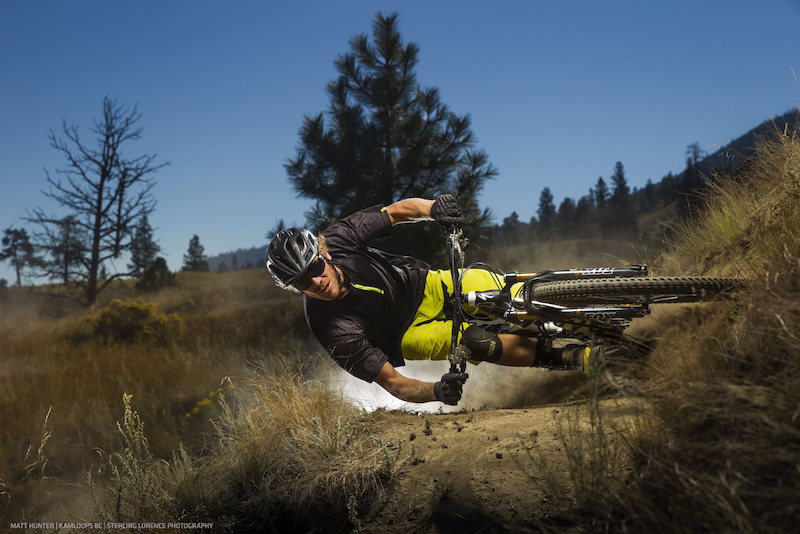How did Matt hunter do it?

Hi Lee,
I don’t know if you saw this photo yet:
http://www.pinkbike.com/photo/10883974/
Can you explain how this is even possible? It might make for a good lesson on cornering for all of us who can’t come close to this. The only thing I can think of is he must be going like Mach 10.
Jim
UPDATED with Matt Hunter’s side of the story!
Jim!
What a great question, and one I’ve been getting a lot.
First the famous photo. It’s by Sterling Lorence and appears on Pinkbike.com.
And the video:
I’ve asked Matt about this. Waiting on a response.
In the meantime, here are some thoughts:
Rad!
From a pure cornering standpoint, that is a crazy lean angle. I’m measuring an overall lean angle (contact patch to center of mass) between 80 and 85 degrees.
According to my handy-dandy cornering calculator, a 80-degree lean angle correlates to a 6G turn. A 85-degree lean angle correlates to a 10G turn.
Matt is not pulling 6-10 Gs!
• Look at his Fox 34 fork. It is in the middle of its travel, which indicates his fork is being crushed by perhaps twice his body weight — not 6-10 times his body weight.
• Matt is a very special human, but he’s a human. I can’t see him supporting 6-10X times his body weight — especially with such poise.
• The biggest corning force I’ve measured is about 3Gs. That relates to a ~70-degree lean angle. We see that on well built pump tracks and in big, steep, fast berms.
OK, so Matt is not cornering at 80-85 degrees.
So what’s going on?
I think this is more of a wall ride. It looks like:
• Matt is riding super fast and with absolute impunity. He is skilled, strong and riding a great bike.
• As he reaches the top of the rise and the crux of the turn, he leans way to the inside. If this was a normal turn, he’d fall to the right.
• However, this turn has a downhill exit. He lets his body fall out of the turn, then he brings everything together later (we presume).
It’s not unusual to see this kind of angle on a wall ride.
That’s my opinion. I hope Matt gets back to me on this.
Ride with impunity!
Lee
Matt Hunter says:
Matt got back to me via Facebook, and we had a nice chat while his 7-month-old boy chattered in the background.
This looks to me like a wall right, right?
Yes. It absolutely is a cornering wall ride.
I was going pretty fast, entering the turn, then I saw it has this beautiful wall on the back. It’s cut directly into the hill. There’s no worry is the berm strong enough … the berm is the Earth.
You enter the turn, you see that wall and you just lean it over. When you turn the bike down, that moment happens. You fully commit to the fall, then, when the bike goes light, you pull it under you and ride it out.
Bar drag!
To be honest, I was pleasantly surprised my bar was dragging. The first few times, I was like holy shit my bar is dragging. I’ve always wanted to do that. Fact is, if you ride that corner with good speed, that’s what happens naturally.
This is a real turn on a real trail!
The corner is on an XC trail at Kamloops Bike Ranch. “This is a real turn on a real trail, which makes it pretty legit.” Matt gives huge credit to bad ass trail builder Brad Stuart.
Check out the hashtag #nobradnoride.
Matt, thanks for much for your time and stoke!
Lee
Know more. Have more fun!
Join the leelikesbikes mailing list:

Leave a Reply
Want to join the discussion?Feel free to contribute!